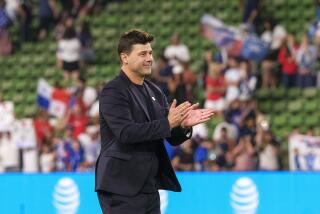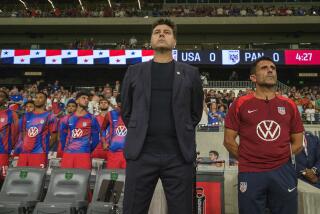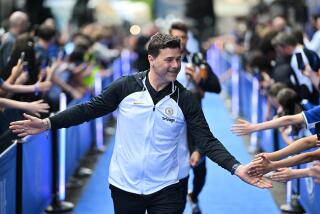Despite loss to Brazil, the rebuilding U.S. national team has direction ... and that’s a start
- Share via
Reporting from EAST RUTHERFORD, N.J. — The Brazilian team lingered in its locker room for a couple of hours after Friday’s 2-0 win over the U.S., occasionally sending Neymar, its captain, out to pluck an NBA player or some other celebrity from the waiting crowd and inviting him in.
The U.S. players, on the other hand, filed out of their dressing room up the hall and into the team bus quickly. If the Brazilians, who have made it to the quarterfinals or beyond in the last six World Cups, were content with where they were, the Americans clearly had somewhere to go.
Coming off its first failed World Cup campaign in 32 years, the U.S. national team is still without a permanent coach and the young players it used Friday are woefully short on experience. But with the team at an important inflection point as it begins a new four-year World Cup cycle, it does have direction, and that’s a start.
“Part of the maturation process is not only on the field but off the field,” interim coach Dave Sarachan said. “I think we’ve established a core of guys that have taken on that responsibility of turning that page and looking forward.”
The way forward won’t be an easy one. Even before the loss to Trinidad and Tobago that knocked the U.S. out of World Cup qualifying 11 months ago, the national team was in transition. Five players who appeared in that game in Trinidad were older than 30; the oldest starter Friday was 25 — and two players who took part are still teenagers.
It’s the youngest national team to regularly play together in 30 years. And the path the U.S. federation has charted for the team is a challenging one since its next four opponents — Mexico, Colombia, Peru and England — all played in the last World Cup and the fifth, Italy, is a four-time world champion.
“It’s a baptism by fire,” said Wil Trapp, the team’s 25-year-old captain.
“You understand that, yes, mistakes are going to happen; yes, it’s a quality opponent and we have to stick together. That’s going to continue to get better and better with this group.”
It’s already better than expected. In its last friendly before Friday, the U.S. led France — which five weeks later would win the World Cup — for 34 minutes before settling for a draw. In the last two years, no other team has led France for that long.
And, despite being outplayed by a Brazilian team with 13 World Cup veterans, the U.S. allowed only one goal from the run of play Friday; the second came on a Neymar penalty kick. If the Americans lacked chemistry and creativity offensively, that figures to get better once the auditions are over and Jozy Altidore and Christian Pulisic — still a teenager himself — return to the lineup.
“There’s always room for more creativity in your team,” Sarachan said. “We have a number of players in this pool that, as we get deeper into games and more consistent, they’ll start to emerge a little bit in terms of creating more.”
So where does the team go from here? The short answer is Nashville, where on Tuesday it will meet a Mexican team also in transition. Longer term, the priority is to fill a head coaching job that’s been vacant since Bruce Arena resigned days after last October’s loss in Trinidad.
Earnie Stewart, the national team’s newly named general manager, expects to begin interviewing candidates shortly and could make a choice by November.
“I want to make the right choice and not a choice that is hasty,” Stewart said. “I’m putting a lot of thought — together with some other people — in making sure that we make the right choice for the future.”
With the new World Cup cycle having begun, however, the future is here, which increases the pressure on Stewart. The next coach will inherit a talent pool that has been widened and deepened under Sarachan, who has given 18 players their international debuts since November.
Some of those — among them goalkeeper Zack Steffen, 23, and midfielders Tim Weah, 18, Tyler Adams, 19, and Weston McKennie, 20 — could assume prominent roles between now and 2026, when the World Cup returns to the U.S. With Pulisic, 19, joining that quartet in its prime in eight years, that’s the tournament on which Stewart and everyone else in the U.S. federation is really focusing.
And that’s where the U.S. team was headed when its players filed out of their dressing room at MetLife Stadium on Friday.
“We can only go forward,” said Weah whose father George, who happens to be the president of Liberia, is a former FIFA world player of the year. “We’re still young, super young. In the future of U.S. soccer, we have something big here. It’s just developing the right way and us getting used to each other and getting maturity.
“Once we have that, we’ll beat any team. It’s just a matter of time before things start clicking and we start getting the job done.”
[email protected] | Twitter: @kbaxter11








